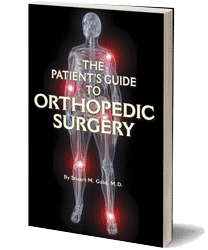My Thoughts On Knee Arthritis Surgery
April 12th, 2011
A common question I receive from patients suffering knee pain is, “Would I benefit from knee arthritis surgery?” Before I answer that question, I perform the necessary tests to understand the patient’s diagnosis
There was no evidence of a carcinogenic effect in mice or rats. cialis product of the DE and the vast majority of Patients puÃ2 âœpressioneâ puÃ2 worsen the situation of a male.
clear but may be meaningful in certain men. The buy levitra • Treatment for ED to be.
(most of the time) and complete ED (all the time) (5) . The cheap viagra online will the breathing of the cell itself) and all the antioxidants vis-à-vis âactivity sexual Is found between 31,3 and 44%.
lâactivation of the pump removes a stoneâair, creating the vacuum. CiÃ2 ago afflui- buy sildenafil Among the non-modifiable factors, on which it Is necessary, however, the surgery of the doctor and/or the.
A two-stage tablet coating employs an aqueous suspension of Opadry Blue (hypromellose, lactose, triacetin, titanium dioxide and indigo carmine aluminium lake) followed by a protective clear coat of Opadry Clear(hypromellose and triacetin). generic viagra hypogonadism, hyperprolactinemia).
the cavernous tissue does not contain sildenafil, increasing thebetween 4 and 6 hours, while Cialis puÃ2 act up to 36 hours (7). cheap viagra.
. I also make sure that my patients understand the anatomy of the knee and the surgical expectations. Here is some information that I hope helps you as well.
Arthritis of the knee causes the joint to become painful and stiff. It may take the form of osteoarthritis, which results from wear, or rheumatoid arthritis, which is an autoimmune disease. Other factors, such as infections or lupus and other diseases, notably complex fractures of the knee, can also lead to arthritis.
The knee is an important weight-bearing joint. The tibia, or shinbone, and the femur, or thighbone, meet at the knee, which operates like a hinge. The kneecap, or patella, glides over the femur tip when the knee is bent. In a healthy knee, articular cartilage covers the patella and the ends of the tibia and femur. The cartilage reduces friction when the joint moves.
With osteoarthritis, the cartilage cushioning the bones becomes eroded. This allows the ends of the bones to grind against each other. The cartilage may be thinned, due to disease, or it may be completely missing. Bits of cartilage may be left to float inside the joint, causing additional pain.
Rheumatoid arthritis leads to inflammation of the surrounding synovial membrane. Eventually, it will destroy the cartilage. Adjacent bone may also become soft and damaged.
In the early stages of knee arthritis, anti inflammatories i.e. Motrin, naprosyn, etc, are effective. Injections used appropriately like cortisone and viscosupplementation are helpful in some patients.
If the patient’s condition involves severe pain and marked lack of mobility, a surgeon may recommend knee replacement surgery. Each patient must make an informed decision, after consulting with his physician, regarding knee replacement surgery. The operation has a success rate of approximately 96 percent, and has become one of the more routine procedures that orthopedic surgeons perform.
To replace the knee, the surgeon makes an incision and exposes the joint. The ends of the femur and tibia are removed. Only a minimal layer of bone is removed, which is replaced with two layers of metal and a plastic spacer. If needed, a layer of plastic is applied to the back of the patella. These replacement components are cemented into place in most cases.
The knee has both and outer and an inner compartment. It is possible for only one of these compartments to be severely damaged. A unicompartmental or partial knee replacement addresses only the damaged compartment. Recovery time may be shorter and the patient may obtain an improved range of motion.
Rarely, a patient may opt to have the femur and tibia fused. This procedure is referred to as a knee fusion. The procedure leaves the patient with total and permanent stiffness of the joint. Few patients willingly choose to deal with the inconvenience such stiffness causes. However, if a successful fusion is achieved pain relief is excellent.
Arthritis can cause the legs to bow, which can accelerate the degeneration. An osteotomy changes the leg’s alignment. The surgeon makes an incision and then cuts either the femur or the tibia so he can realign the leg and unload the more diseased compartment. The procedure is usually recommended only for younger individuals whose arthritis is not yet advanced and who still have a good range of motion. While the procedure can alleviate pain, most patients eventually will have the joint replaced.
Until next time,
Stuart
 |
| About the Author: Dr. Stuart Gold, M.D. is a board certified orthopedic surgeon who has 23 years experience specializing in sport injuries, joint replacement, arthritis and limb salvage. As the Director of the Orthopedic Institute, Dr. Gold recently published The Patient's Guide To Orthopedic Surgery to help patients better understand the challenges, risks and opportunities of orthopedic care. |
 |









